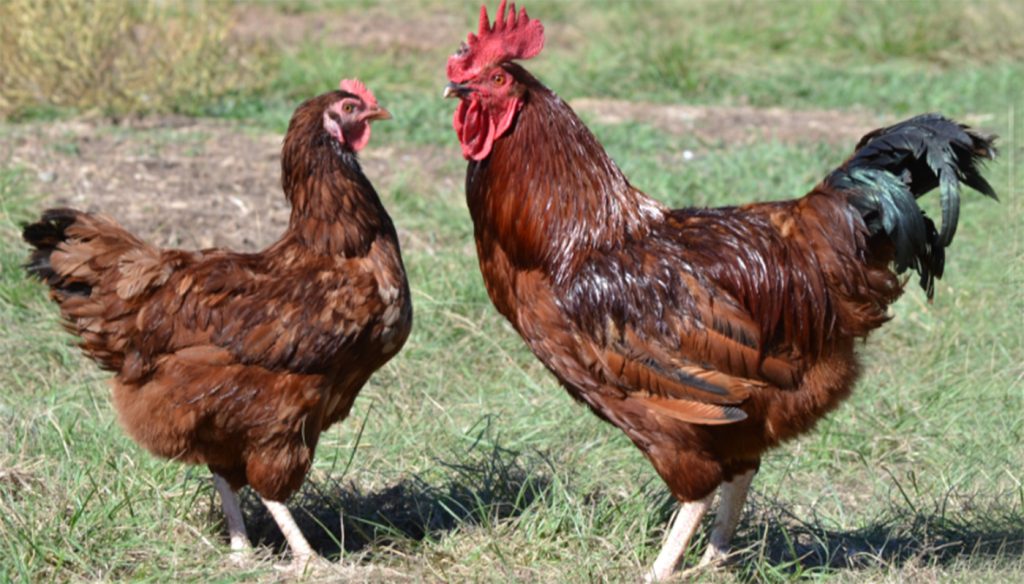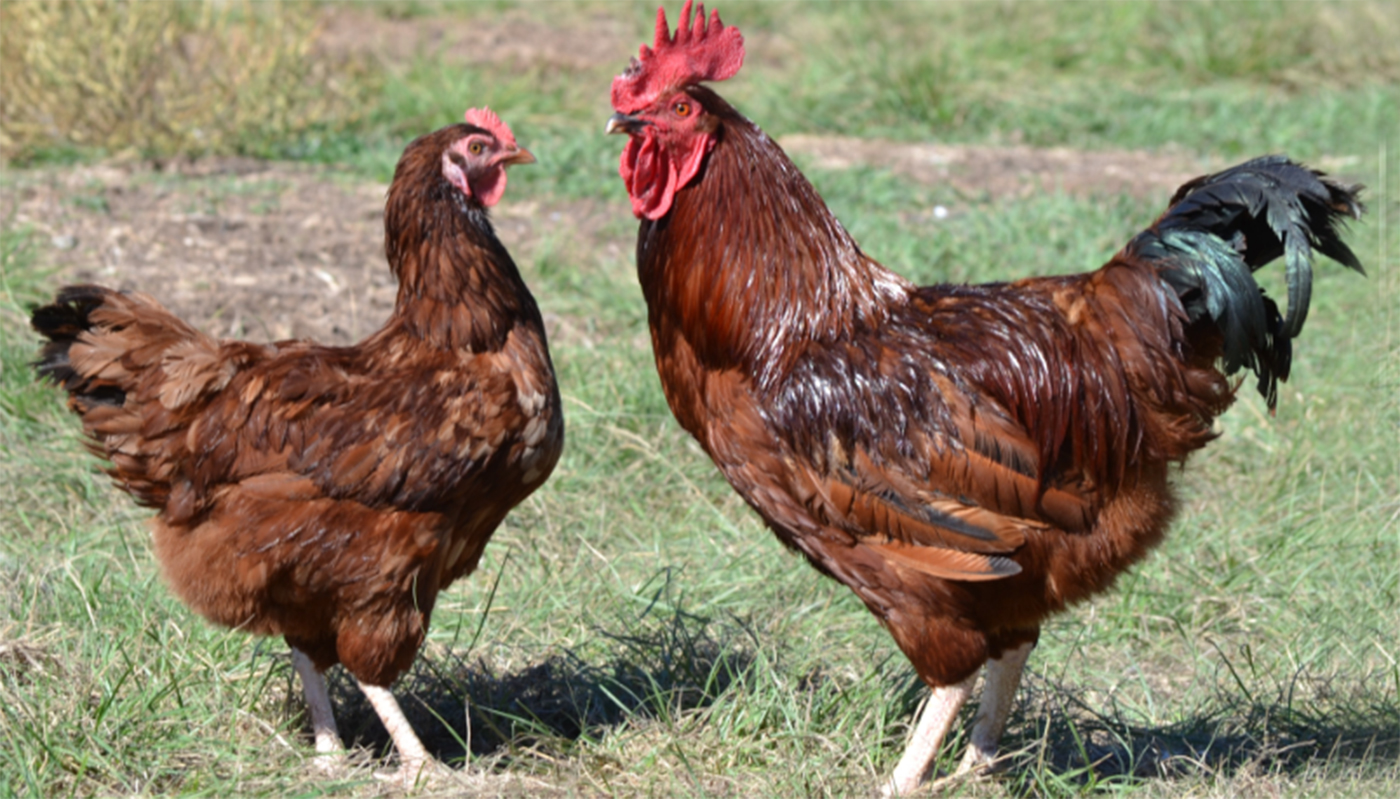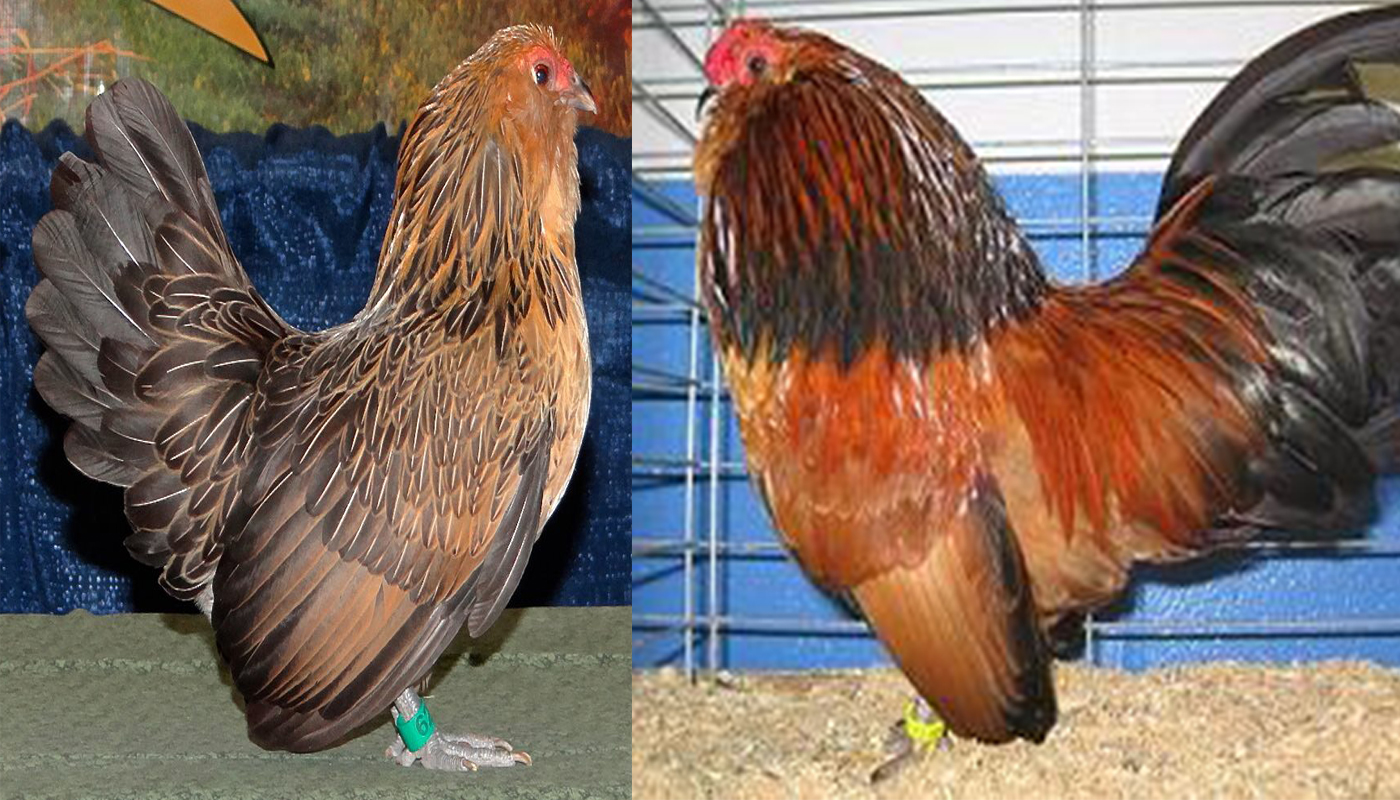
The Rhode Island Red is a beautiful bird and a prolific layer of large light brown eggs. They are one of the most well-known dual purpose and industry breeds in the world.
Not only are they great egg layers and have good quality succulent meat but they have also been used in the development of a lot of other commercial hybrids such as the ISA Brown.
There are two strains of the Rhode Island Red or as it is sometimes referred to RIR. These are what is called the production strain which is lighter in color than the non-industrial strain. They were bred selectively for their egg laying abilities and do not become broody.
Then there are the heritage or exhibition strain of the Rhode Island Red breed. Their coloring is richer and darker than the production strain. Their bodies are larger, they are heavier and they do not produce as many eggs as the production strain do.
| Country of Origin: | American |
| American Poultry Association: | Ye, they are recognized as a breed of chicken in the United States Accepted to the Standard of Perfection by the American Poultry Association in 1904 |
| Chicken Category: | Large Breed |
| Chicken Class: | American |
| Bantam Variety Available? | Yes – Single Comb Clean Legged Bantam Classification and Rose Comb Clean Legged Bantam Classification |
| Good Starter Chicken? | Yes, their easy-going nature and good foraging ability make them a good started chicken |
IDENTIFICATION⇒ |
Appearance/Body: Rhode Island Reds have a broad deep body which is often referred to as brick-like. They have had a medium sized tail which is held slightly higher than their flat backs. They have soft feathering, long clean pinkish color legs with four toes. Their wattles, earlobes and comb are a bright red with a yellow beak and dark eyes.
Color(s) Red
Comb: They have a single comb with some Bantam varieties having a rose comb
Ave. Weight: Pullet: 5.5 lbs. Hens: 7 lbs. Cockerel: 7.5 lbs. Rooster: 8.5 lbs. |
PURPOSE⇒ |
Eggs: They are very good egg layers.
They lay large to extra-large light brown eggs They lay about 250 – 300 eggs per year They will lay throughout the year They start to lay eggs from around 26 weeks old.
Meat: They have yellow skin
They make a great table bird
Breeding: They can be bred
The hens are not very broody They do not make good brood hens They will sit their eggs but intermittently, so incubators of brood hens will be needed to hatch the chicks They will raise their chicks and make exceptionally good mothers for hens that do not like to hatch their chicks They have been known to foster other chickens/breeds chicks
Foraging: They are really good foragers and free-range chickens.
Show Bird: Their beautiful rich glossy deep red plumage and perfectly pretty red faces make them a very good show bird
Pets: They make a good pet
Other: These easy-going chickens are full of fun and have a great character that is sure to liven up any sized flock
|
CHARACTERISTICS |
|
|---|---|
| Life Expectancy: | The average lifespan is 8 years |
| Health: | A breed that is bred to be a hardy bird with no known health issues |
| Temperament: | Calm, friendly, inquisitive, active and easy going. The roosters can get very aggressive during the mating season though. |
| Flyers? | They can fly but are not very flighty |
| Noisy Birds? | They are not too noisy but have their chatty moments |
| Interaction with other chickens: | They are happy to mingle and socialize with other chickens/breeds. Except during mating season, it is best to isolate the rooster who gets rather aggressive |
| Good with kids? | They are easy to handle and are found around supervised kids. |
| Socialize Behavior? | They will warm up to other domestic animals as they get used to them being around the garden |
| Known predators: | They have their share of usual predators, such as foxes and feathery predators from above such as hawks. Most dogs and cats will leave them alone, but it is best to be cautious with them around your chickens. Check with local animal shelters, zoos, vets, animal control and or pet stores about common predators in your area. |
| Conservation Status: | These birds conservation status is recorded as “watch”. It is best to check on any special license or instructions that may be set up for owning these birds. This can be checked with your local or national conservation centers. |
IDEAL ENVIRONMENT |
|
|---|---|
| Garden Size: | They will bare confinement without a fuss but do prefer to roam free as most animals do. They will easily adapt to most garden/homestead sizes. |
| Ideal Climate: | They are quite climate tolerant although they tend to be better in the colder climates than the warmer ones. |
| Ideal Coop: | The rule of thumb for any coop is 50 cm x 50 cm per hen/rooster in the coop. Ensure there is a good space for the nesting boxes and nightly roosting rails at least 1.5 inches wide. Good ventilation for air but not too drafty especially in winter. It is always a good idea to raise the coop off the ground to give the birds a dry place to roost and lay especially in wet weather.For Bantam breeds, it is best to have the coop in a protected shed or barn. |
| Ideal Coop Run: | They do have the potential to fly and for safety sake, it is always best to completely cover the coop run |
| Ideal Flock Size: | As long as they can wander around and enjoy their day and have a friend to share their coop they are happy in any size flock. |
| Special Instructions: | They do not have any special requirements |
| Accessories: | The following accessories are ideal for your coop: Nesting boxes Straw for the boxes and roosting area Roosting rails Perches Water troughs/bowls Food bowls/feeders Heating lamp(s) Animal carrier for transport purposes |
| You may Also Like: | 45 FREE DIY CHICKEN COOP PLANS, TUTORIALS AND DESIGNS |
WHERE TO BUY THEM |
|
|---|---|
| Live Poultry Outlets: | As Rhode Island Reds are still used for industrial purposes, they are pretty easy to find at some live poultry outlets. You may even be able to find rescue Rhode Island Reds that have been retired from commercial farms. |
| Internet Poultry Websites: | Purely Poultry usually always have access to Rhode Island Red hatchlings. It is important to check the authentication of the chickens and the Internet seller’s reputation before buying from them. |
| Organizations: | Associations such as the American Poultry Association and the American Livestock Conservancy may also have a list of reputable breeders nationally and or in your area. |
| Breeders Clubs: | Feather Site has breeder contact information and other helpful advice. There is also the Rhode Island Red Club of America that is filled with valuable advice, tips and information for Rhode Island Red potential/existing owners. |
| Other: | The organizations and or breeders listed above may also have a host of valuable information about your chickens. They will also be able to provide you with any special instructions, problems, etc. about your chickens. |
HISTORY
The Rhode Island red was developed between 1880 and 1890 in a small town in Rhode Island called Little Compton.
To improve the stature of local American breeds it was quite a common practice for sailors from New England to bring back exotic chickens from the travels.
One of these exotic chickens was a Malay which forms part of the Rhode Island Reds heritage and is where it gets it dark rich coloring from. The Rhode Island Red also inherited its strong constitution and hard feathering from the Malay. Another of the breed’s ancestors were the Brown Leghorn, Shanghai and Java chicken breeds.
The developers of the Rhode Island Red wanted to develop a chicken what was climate hardy, a good table bird and would lay a large number of eggs.
Over time the birds have been selectively bred to increase the egg productions with a result the production strain of this breed has become lighter in both weight and color as well as a lot less broody. These production hens have the ability to lay up to 300 good sized eggs per year. They also star laying at the age of 6 months.
The production Rhode Island Reds are still to this day enjoying great popularity with the breed becoming more and more productively streamlined.
But the old type Rhode Island Reds numbers have slowly been declining and are listed in the American Livestock Conservancy as a breed to watch.
These hens and rooster are a lot larger and richer color, they are not as docile as the production breed. The females tend to get really broody and make for good sitters and excellent mothers. The roosters tend to be a bit aggressive and quite protective of their flock.
NOTES / SPECIAL INSTRUCTIONS
As they are registered as a “watch” conservation status they may need an extra license to own or keep in your garden. For advice on what the bird’s conservation status and orders are please check with your local conservation department.
For breeders, it is imperative that you always check your bird’s bloodlines and ensure you are buying your birds from a reputed breeder/farm. In order to sell birds of such stature, they have to be recorded and documented, always check with local animal breeding organizations for these records.
These legitimate documents are also required should you wish to show your bird(s) in various poultry shows/competition showings.
For information and advice on adopting rescued animals, you can visit or contact your local animal welfare center.
Video
USEFUL LINKS
- Caring for your Chicken
- Feeding
- Health
- Socializing your Chicken
- Breeding Chicken
- Raising Chickens A-Z
- Hatching Eggs
- What is Molting
- Animal Shelter (ASPCA)
- American Veterinary Medical Association
- American Poultry Association
- American Animal Welfare Society
- American Animal Control
- American Animal Husbandry Society
References
- https://en.wikipedia.org
- https://livestockconservancy.org
- https://www.roysfarm.com
- https://www.mypetchicken.com
- https://www.backyardchickens.com
- https://www.feathersite.com/
 White-faced Black Spanish Chicken Breed – Everything You Need to Know
White-faced Black Spanish Chicken Breed – Everything You Need to Know Conditions that can affect a Chicken Respiratory System
Conditions that can affect a Chicken Respiratory System Shamo Chicken Breed – Everything You Need to Know
Shamo Chicken Breed – Everything You Need to Know Ayam Cemani Chicken Breed – Everything You Need to Know
Ayam Cemani Chicken Breed – Everything You Need to Know Rhode Island White Chicken Breed – Everything You Need to Know
Rhode Island White Chicken Breed – Everything You Need to Know HOW TO TELL IS A CHICKEN IS SICK
HOW TO TELL IS A CHICKEN IS SICK 10 Chicken Breeds for the Colder Climates
10 Chicken Breeds for the Colder Climates Sultan Chicken Breed – Everything You Need to Know
Sultan Chicken Breed – Everything You Need to Know 10 of the Smallest Chicken Breeds
10 of the Smallest Chicken Breeds Sicilian Buttercup Chicken Breed – Everything You Need to Know
Sicilian Buttercup Chicken Breed – Everything You Need to Know Color Varieties that are found in a lot of the Various Chicken Breeds
Color Varieties that are found in a lot of the Various Chicken Breeds Top 10 Jumbo and Extra Large Egg Laying Chicken Breeds
Top 10 Jumbo and Extra Large Egg Laying Chicken Breeds